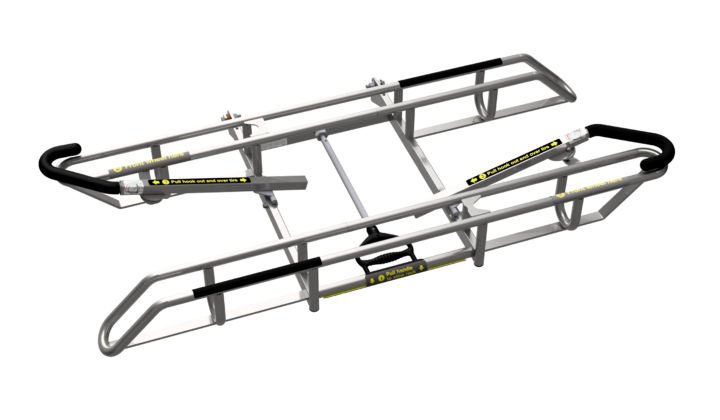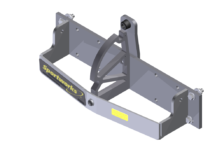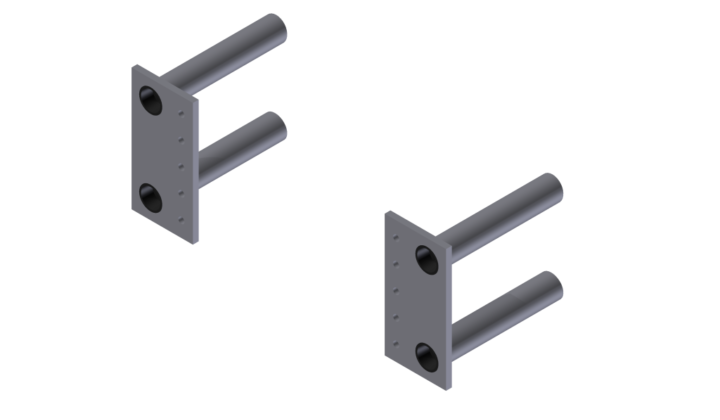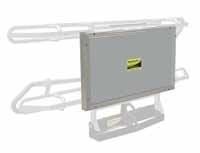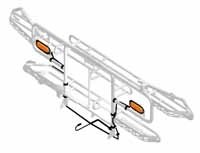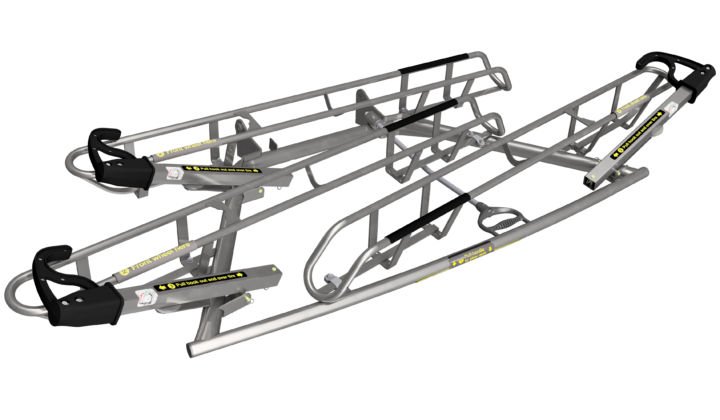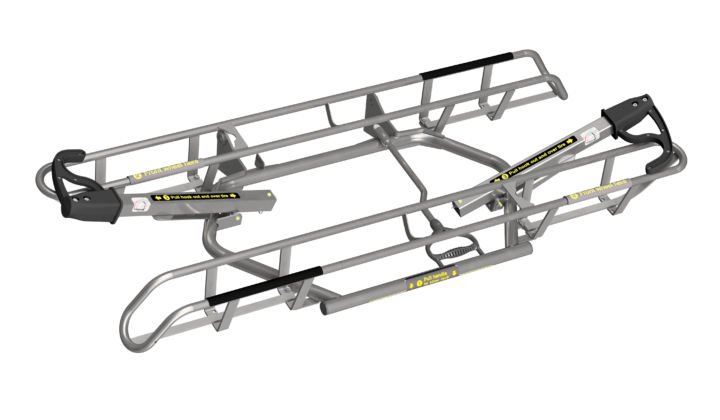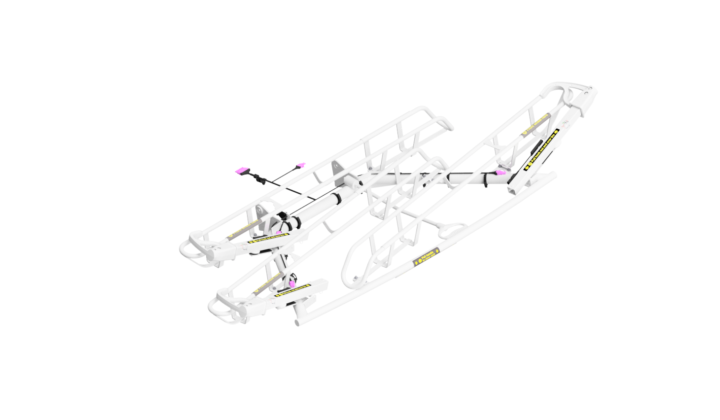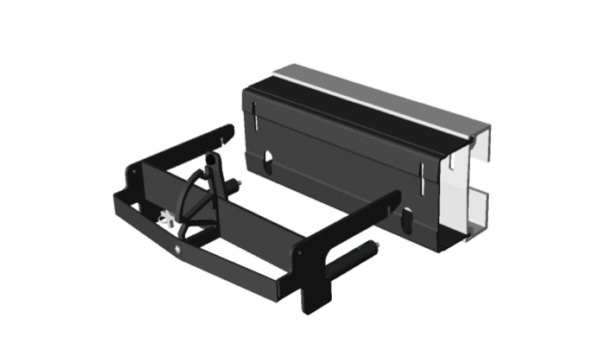DL2 NP™ - Narrow Profile
NEED HELP? 888-661-0555 / M-F: 7AM - 4PM PACIFIC
Drawings & Downloads
With the smallest footprint available, the DL2 Narrow Profile (NP) is 10" narrower than the DL2 rack, and is ideal for small transit vehicles and when minimal headlight and turn signal interference is required. This all steel design carries up to two bikes, and accommodates wheel sizes from 20" to 29" and up to a 44" wheel base. The DL2 NP is available in stainless or mild steel, and comes in a variety of colors/finishes.
The DL2 NP's unique No Scratch™ support arm secures the front tire without straps or cords and prevents damage to bicycles. This translates into simple and intuitive passenger use, and quick loading and unloading times to keep the bus on schedule. With a minimal lifting weight of 19 lbs, the DL2 NP is lightweight, easy to use, and falls well below OSHA and NIOSH limits.
For information about safety, vehicle requirements, and other usage information please refer to our FAQs.
Hardware
All Sportworks bumper-mounted bike racks require a Pivot Plate, Brackets and Bolt Kit for proper installation.
Narrow Profile Pivot Plate
The narrow profile (NP) pivot plate measures 16 7/8” wide, and provides the mounting and pivot point exclusively for Sportworks DL2 NP bike rack. The pivot plate is connected to bumper brackets, and enables the bike rack to move between the stowed and deployed positions.
Hardware
Sportworks offers two primary types of Brackets that secure the Pivot Plate and Bike Rack to a vehicle bumper.
Stand-Off
The Stand-Off is the most common bracket type, and attaches through holes drilled into the front of the vehicle bumper. Stand-Off brackets are available in a variety of lengths, and do not require removal of the bumper for installation. The following information may be required to determine the proper fit for your vehicle: vehicle make and model, vehicle year, bumper manufacturer and type.
C-Bracket
The C-Bracket fits around the bumper by attaching to the frame, and alleviates the need to drill holes through the front of the vehicle bumper. C-Brackets come in a variety of sizes, and require removal of the bumper for installation. The following information may be required to determine the proper fit for your vehicle: vehicle make and model, vehicle year, bumper manufacturer and type.
Ten Second Bracket
The Ten Second Bracket™ (TSB) is the result of a joint development effort between Romeo Rim bumpers and Sportworks Bike-Racks-for-Buses™. The TSB offers an integrated pivot plate and bumper bracket assembly that can be installed or removed in 10 seconds or less. Best of all, the bracket is safely secured using hand knobs so no tools are required.
Some TSB models come with dual mounting points to accommodate both Sportworks standard width and DL2 NP racks.
Accessories
Advertising Panel
Maximize advertising space and create a new stream of revenue
Heavy-duty construction is bus washer safe
13” x 32”, 14” x 44” and custom frame sizes available
Quickly and easily attaches to most Sportworks racks
Deployment Indicator Kit
Dashboard mounted light notifies driver when rack is deployed
Increased safety feature
Attaches to most Sportworks racks
Torsion Spring Kit
Reduces the lifting weight when stowing and deploying the rack
Corrosion resistant design with stainless steel spring
Easily attaches to most Sportworks pivot plates
Demonstration Stand
Easily demonstrate bike rack loading/unloading without a vehicle present, for education or training purposes
Heavy-duty construction can support a rack fully loaded with 3 bikes
Fast and easy to assemble, disassemble, and transport
More information here: Demonstration Stand
Turn Signal Kit
Aftermarket turn signals mount directly to rack for increased visibility
Increased safety feature
Available for select Sportworks racks
Excellent for addressing vehicle light source interference issues
Quick-Release Pivot Bolts
Quick-release hand knob allows tool-less removal of bike rack from pivot plate
Provides fast and easy access to bus-front for maintenance and towing
Highly corrosion resistant stainless steel, zinc and copper construction
How to Use
Sportworks Transit Racks - Quick, Easy and Intuitive!
Lower Rack
Approaching from the curbside, the rider lowers the rack with one hand while supporting the bike with the other hand. This durable rack is as easy to raise as it is to lower.
Load Bike
After lowering the rack, the rider places the bike into one of the rack’s open wheel trays. All bike positions are completely independent of each other, making it easy to load or unload bikes with others already loaded in the rack.
Secure Wheel
To secure the bike, simply pull the unique self-storing support arm out and over the front tire. The handle should be placed as close to the front brake and head tube as possible to ensure safety and security of the bike, and in all cases the handle must be closer to the head tube than the highest point of the tire.
Related Products
Apex 3™
The Apex 3 is our modular 3-position bike rack and it has the most compact layout of any 3-position transit rack. The Apex 3™ is recommended for use on full-sized, cutaway and paratransit vehicles.
Apex 2
The Apex 2 is our modular 2-position transit bike rack and it is the latest addition to our full line of transit tough bike racks.
DL2™
The DL2 is the bike rack that started it all. Used by hundreds of transit agencies throughout North America, this all steel design remains a popular choice for carrying up to two bikes.
Bike Counter Harness
The first and only way to automatically count bikes on your buses.
Ad Panel
Increase revenue with our integrated ad panel designed to fit our transit racks.
Standard Ten Second Bracket™
The Ten Second Bracket (TSB) is an integrated pivot plate and bracket assembly that allows fast and easy removal of Sportworks front bumper-mounted bike racks for towing and maintenance.

